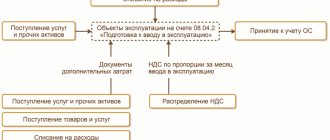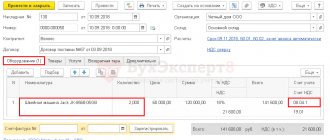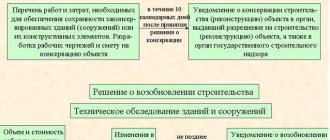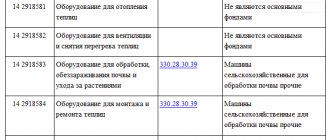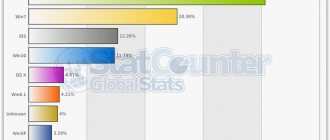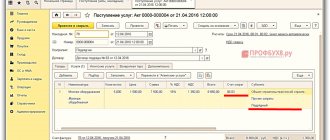Methods for calculating depreciation
Accounting has four options for calculating depreciation. You can learn more about the methods for calculating depreciation in PBU 6/01.
Depreciation should be calculated from the month following the month in which the asset was registered. Let’s say the computer was capitalized in October 2018, the accountant will begin calculating depreciation from November 1, 2018.
Depreciation calculation methods:
- Linear.
- Reducing balance method.
- A method of writing off cost based on the sum of the numbers of years of useful life.
- The method of writing off the cost is proportional to the volume of products (works).
Please note that the listed methods relate to depreciation of fixed assets in accounting. In tax accounting, there are only two ways to calculate depreciation charges - linear and non-linear.
Submit electronic reports via the Internet. Kontur.Extern gives you 3 months free!
Try it
Linear method
Most often, practicing accountants use this method. It is very simple and clear.
To find out the amount of monthly depreciation, you should find the product of the original cost of the asset and the depreciation rate.
Depreciation rate = 1/SPI (months) x 100%.
Example. Funtik LLC registered a Samsung computer. The initial cost is 49,320 rubles. SPI - 5 years (60 months).
The depreciation rate for a Samsung computer = 1/60 * 100% = 1.67.
Monthly depreciation = 49,320 x 1.67% = 823.64 rubles.
Due to rounding, the amount of depreciation in the first months will differ from the amount of depreciation in the last month (the total amount of depreciation for the entire period should not be more than the original cost).
In practice, it is customary to calculate depreciation in a simpler and more accurate way.
Monthly depreciation = 49,320: 60 = 822 rubles.
Submit electronic reports via the Internet. Kontur.Extern gives you 3 months free!
Try it
Reducing balance method
To find out the required amount, you will need the residual value of the fixed assets at the beginning of the year, SPI. Companies also have the right to use an acceleration factor from 1 to 3.
Example. Funtik LLC uses OS in production, the residual value of which as of 01/01/2018 is 49,320 rubles (the same amount is the initial cost). SPI - 60 months. The coefficient is set at 1.3.
2018
49,320: 60 x 1.3 = 1068.60 rubles per month
The amount of depreciation for 2021 will be 12,823.20 rubles (1068.60 x 12).
2019
Residual value as of 01/01/2019 = 49,320 - 12,823.20 = 36,496.80 rubles.
36,496.80: 60 x 1.3 = 790.76 rubles per month.
Depreciation in subsequent years is also calculated in this way. The residual value of the operating system is always taken as a basis. Thus, every year depreciation charges decrease.
Submit electronic reports via the Internet. Kontur.Extern gives you 3 months free!
Try it
Method of writing off cost based on the sum of the numbers of years of useful life
The calculation is based on the initial cost and the sum of the number of years remaining until the end of the investment project.
Example. Funtik LLC uses OS in production, the initial cost of which is 49,320 rubles. SPI - 48 months (4 years). Depreciation is accrued from 01/01/2017.
First, let's determine depreciation rates.
2017 = 4 / (1 + 2 + 3 + 4) x 100% = 40%.
2018 = 3 / (1 + 2 + 3 + 4) x 100% = 30%.
2019 = 2 / (1 + 2 + 3 + 4) x 100% = 20%.
2020 = 1 / (1 + 2 + 3 + 4) x 100% = 10%.
This method allows you to write off most of the cost of the OS in the early years.
The amount of depreciation is determined by multiplying the original amount by the calculated rate.
Depreciation amount for 2021 = 49,320 x 40% = 19,728 rubles.
Monthly depreciation in 2021 = 19,728: 12 = 1,644 rubles.
The method of writing off the cost in proportion to the volume of products (works)
With this method, quantitative indicators of production (pieces, kilograms, etc.), the initial cost and the planned productivity of the operating system are taken as a basis.
Example . Pound LLC produces spare parts on the A458 machine. The machine was purchased in April 2021 and immediately put into operation. The initial cost of the A458 machine is 589,000 rubles. Over the entire period of use, it is planned to produce 350,000 units of products on this machine. In May, the machine produced 4,200 parts, in June - 3,100 units.
Depreciation in May = 589,000: 350,000 x 4,200 = 7,068 rubles.
Depreciation in June = 589,000: 350,000 x 3,100 = 5,216.86 rubles.
Submit electronic reports via the Internet. Kontur.Extern gives you 3 months free!
Try it
Composition and valuation of fixed assets
For production activities, enterprises need fixed assets (implements of labor); they repeatedly participate in the production process, transferring their value in parts to the created product, without changing their material and natural form. Fixed assets also include: residential buildings and buildings for cultural and domestic purposes, household equipment, computer equipment, adult working and productive livestock, perennial plantings worth more than 50 minimum wages per unit, the service life of which exceeds one year.
On account 01 “Fixed Assets”, separate subaccounts keep records of fixed assets that are in operation, in stock, on conservation or transferred to ordinary (production) lease. Accounting for leased fixed assets received under ordinary (industrial) leases is carried out by the lessee using the balance in account 001 “Leased fixed assets”. On account 01 “Fixed assets”, object-by-object analytical accounting of fixed assets is organized in the places where they are located (in workshops, production facilities, departments, etc.)
Objects of fixed assets are grouped in accounting in accordance with the requirements of statistical reporting into production and non-production (the latter by industry: healthcare, housing and communal services, etc.), and further by functional groups: buildings, structures, working machines and equipment, power machines etc.
Land plots, forest and water areas, mineral deposits transferred for use by the enterprise are not taken into account in account 01 “Fixed Assets”. But the same objects that are the property of the enterprise (purchased or transferred into ownership by state bodies) are accounted for in separate sub-accounts opened in account 01 “Fixed Assets”.
The main tasks of accounting for fixed assets:
- control over their availability and safety from the moment of acquisition to the moment of disposal;
- correct and timely calculation of wear and tear;
- obtaining information for the correct calculation of property tax transferred to the budget;
- control over the correct and effective use of funds for reconstruction, modernization and repair of fixed assets;
- control over the effective use of fixed assets in terms of time and capacity;
- obtaining data for reporting on the availability and movement of fixed assets.
The basis for the correct organization of accounting for fixed assets is the approved standard classification of fixed assets and a unified principle for their assessment in accounting.
Classification of fixed assets. Accounting for fixed assets in accounting is carried out according to classification groups in the context of inventory objects. Thus, an inventory object is a unit of accounting for fixed assets. Each object is assigned an inventory number according to the serial coding system, which is retained by it for the entire period of its presence at the enterprise, association, or organization. Inventory numbers are given in acceptance certificates, liquidation acts and other primary documents that serve as the basis for accounting for the movement of fixed assets. The inventory number is indicated on each object.
Fixed assets are varied in composition and are grouped according to certain classification criteria. In accordance with the Standard Classification, fixed assets are divided by type as follows:
- Building.
- Facilities.
III. Transfer devices.
- Machinery and equipment (including power machines and equipment; working machines and equipment; measuring and control instruments, devices and laboratory equipment; computer technology; other machines and equipment).
- Vehicles.
- Tool.
VII. Production equipment and accessories.
VIII.Household equipment.
- Working and productive livestock.
- X. Perennial plantings.
- Capital costs for land improvement (excluding structures).
XII.Other fixed assets.
Based on ownership, fixed assets are divided into owned and leased. The first ones belong to the enterprise and are listed on its balance sheet; the latter were received from other enterprises and organizations for temporary use for a fee.
Based on the nature of participation in the production process, a distinction is made between operating and inactive (in stock or mothballed) fixed assets, and according to their purpose – production and non-production (fixed assets of housing, communal and socio-cultural facilities).
Production fixed assets include: buildings and structures for production purposes, transmission devices, machines, machines, equipment, vehicles, computer equipment, tools, production and household equipment that are directly involved in the production process of manufacturing products (performing work, providing services ). They are located in production (workshops, sections) and functional (departments, services) divisions of the enterprise and are assigned to them.
As part of production fixed assets, their active part is distinguished - machines, equipment, vehicles.
Non-productive assets are fixed assets intended for social and welfare services for members of the enterprise's workforce. These include: residential buildings listed on the balance sheet of the enterprise, consumer service facilities (baths, hairdressers, laundries, etc.), social (clinic, rest home, labor and recreation camp, canteen, etc.) and cultural (cultural center, library and etc.) appointments.
Production and non-production fixed assets can be divided into:
1) active (in operation);
2) inactive (on conservation);
3) in stock.
Based on the nature of participation in core activities and the method of transferring value to production and distribution costs, fixed assets are divided into:
1) active (their participation can be measured by the number of hours of work, the volume of work);
2) passive (buildings, structures). Their participation in core activities cannot be measured in any way.
Valuation of fixed assets in accounting
In accordance with the Regulations on Accounting and Reporting in the Russian Federation, fixed assets are recorded at historical cost. The initial (book) cost includes the cost of construction (purchase) of fixed assets, costs of their delivery and installation at the place of use. It is identified at the time the object is put into operation and remains unchanged throughout the entire period of presence of fixed assets in the enterprise. If fixed assets are purchased by installments or on credit, then the initial cost also includes the amount of interest paid to suppliers. The initial cost of fixed assets acquired through import includes the import tariff paid by the enterprise and customs duties for cargo clearance.
In cases provided for by law, the initial cost includes the value added tax paid upon the acquisition of fixed assets.
The initial (book) value of fixed assets is not subject to change, with the exception of cases of completion and additional equipment of objects in the order of capital investments, reconstruction and partial liquidation of objects. The enterprise's expenses associated with technical reconstruction or capital modification (reconstruction) of existing fixed assets must be added to the initial cost if, as a result of the expenses incurred, there is an increase in the useful life or production capacity of fixed assets, a significant improvement in the quality of products or a decrease in it production cost. These types of expenses are preliminarily accumulated in account 08 “Capital investments”.
The original cost of fixed assets minus depreciation forms their residual value.
The cost of reproduction of fixed assets in modern conditions is the replacement cost.
The initial cost of fixed assets acquired by an enterprise before January 1, 1995 is their replacement cost based on the results of revaluation as of January 1, 1995.
Write-off of costs for internal movement of fixed assets. If a fixed asset is dismantled and then installed in a new location, its original cost remains unchanged. Costs will be charged to the reduction of the accumulation fund or to the net profit of the enterprise. Such costs are not included in production costs.
Items not included in fixed assets. An exhaustive list of such items is given in the Regulations on Accounting and Reporting in the Russian Federation. These include, in particular:
- items that last less than one year, regardless of their value;
- items costing within 50 minimum wages per unit at the purchase price, regardless of their service life, with the exception of agricultural machinery and tools, mechanized construction tools, as well as working and productive livestock, which are classified as fixed assets regardless of their cost;
- fishing gear (trawls, seines, nets, nets, etc.) regardless of their cost and service life;
- gasoline-powered saws, delimbers, floating cable, seasonal roads, mustaches and temporary branches of logging roads, temporary buildings in the forest with a service life of up to two years (mobile heating houses, boiler stations, pilot workshops, gas stations, etc.);
- special tools and special devices (tools and devices for special purposes for serial and mass production of certain products or for the production of individual orders) regardless of cost;
- special clothing, special shoes, as well as bedding, regardless of their cost and service life;
- uniforms, regardless of cost and service life;
- temporary (non-title) structures, fixtures and devices, the construction costs of which are included in the cost of construction and installation work as part of overhead costs;
- containers for storing inventory in warehouses or carrying out technological processes costing within 50 minimum wages per unit at the purchase (manufacturing) price;
- items intended for rental;
- young animals and fattening animals, poultry, rabbits, stuffy animals, bee families, as well as experimental animals;
- perennial plantings grown in nurseries as planting material.
Accounting for depreciation of fixed assets
During operation, fixed assets lose their technical properties and qualities - they wear out. Any objects included in fixed assets, except land, are subject to physical and moral wear and tear, that is, under the influence of physical forces, technical and economic factors, they gradually lose their properties and become unusable. This means that they cannot perform their functions due to technical reasons or economic disadvantage. Physical wear and tear can be partially restored by repairing, reconstructing and modernizing fixed assets. However, over time, repair costs do not pay off and become useless.
Moral wear and tear manifests itself differently than physical wear and tear. Fixed assets in their design, performance, maintenance and operating costs lag behind their newest counterparts. The main thing is that they are not capable of producing products of the same quality that can be produced using more modern technology. Consequently, from time to time there is a need to replace fixed assets, primarily their active part, with new, more modern copies.
Money that reimburses the costs of acquiring and creating fixed assets and is used to replace their worn-out copies with new ones can only be obtained from proceeds for goods and services sold. The cost of goods entering circulation also includes partial repayment of the cost of existing fixed assets. The economic mechanism of gradually transferring the value of fixed assets to the finished product and accumulating a monetary fund to replace worn-out copies is called depreciation. The process of accumulation of the depreciation fund is reflected in the accounting accounts.
To account for depreciation (amortized cost) of fixed assets at enterprises of all forms of ownership, a passive regulating account 02 is provided, for the development of which, if necessary, sub-accounts are opened; 1 - “Depreciation of own fixed assets”, 2 - “Depreciation of long-term leased fixed assets”.
Businesses are required to charge depreciation on a monthly basis. Every month, the enterprise includes the amount of depreciation accrued on its own and long-term leased fixed assets in accordance with established standards in production costs (debit of accounts 20, 23, 25, 26, 31, 43, credit of subaccounts 02-1, 02-2). Depreciation of fixed assets used in construction carried out economically is charged to the costs of capital investments (debit of account 08).
If an enterprise leases individual objects of its own funds for current lease, then it includes the accrued depreciation on them as part of non-operating losses (debit of subaccount 80-3, credit of account 02), and the rent received is attributed to non-operating income (debit of subaccount 76-3, credit subaccount 80-3: debit account 51, credit subaccount 76-3).
Depreciation of fixed assets is accrued during their standard service life (operation) or the period for which the book value of fixed assets is fully included in production costs, after which the accruals stop.
Currently, there are depreciation rates approved by the Government of the Russian Federation, which are differentiated by groups and types of fixed assets. Depreciation rates are set as a percentage of the book value of fixed assets. The exception is mobile road transport, for certain types of which depreciation is calculated as a percentage of the cost of the car per 1000 km.
Based on these standards, it is possible to determine the standard service life (operation) of a fixed asset item.
Example . The book value of the object is 6,000 thousand rubles; depreciation rate 10% The standard service life during which depreciation will be charged will be 10 years. Depreciation in the amount of 50,000 rubles will be charged monthly for this object. [(6000 thousand rubles x 0.1): 12].
Depreciation amounts are calculated in one of two ways.
First way. At small businesses with a small number of inventory items, the accounting department prepares a monthly depreciation statement for fixed assets listed at the beginning of the month, the standard service life of which has not yet expired. The amount of depreciation is determined by multiplying the original cost of the objects by the monthly depreciation rates.
The second method is more common, and its essence is that the monthly amount of depreciation accrued last month is adjusted (increased, decreased) according to established standards in connection with changes (receipt, disposal) of fixed assets for the last month, as well as due to the expiration of the standard service life of machines, equipment and vehicles. Thus, to the amount of depreciation accrued last month, add the amount of depreciation of fixed assets that were again received by the enterprise in the previous month, and reduce it by the amount of depreciation of fixed assets that were retired last month and whose standard service life has expired. In this case, depreciation is calculated monthly in the development table of Form No. 6 of the journal-order accounting form.
Accelerated depreciation (amortized cost) of fixed assets. In accordance with the Decree of the Government of the Russian Federation “On the use of the mechanism of accelerated depreciation and revaluation of fixed assets,” enterprises of all organizational and legal forms can use the mechanism of accelerated calculation of depreciation (wear and tear) of the active part of fixed assets under certain conditions, and the annual rate of depreciation increases by no more than twice. Accelerated depreciation on a large scale must be agreed upon with the financial authorities of the Russian Federation. The decision to use the accelerated depreciation mechanism by the enterprise should be brought to the attention of the tax inspectorate within a month. The exception is machinery, equipment and vehicles with a service life of up to three years, as well as motor vehicles, the depreciation of which is calculated according to standards determined as a percentage of the cost of the vehicle per 1000 km of actual mileage. The accelerated depreciation calculation method does not apply to these objects.
Enterprises can apply this method in relation to fixed assets used to increase the production of computer equipment, materials of new progressive types, instruments and equipment, expand the export of products in cases where they are massively replacing worn-out and obsolete equipment with new, more productive ones, upon agreement on this issue from the Russian Ministry of Economy.
In addition, small enterprises, by Decree of the Council of Ministers of the RSFSR “On measures to support and develop small enterprises in the RSFSR” dated July 18, 1991 No. 406 (clause 7), are allowed to write off additional depreciation charges up to 50% of the original cost in the first year of operation fixed assets with a service life of more than three years, as well as carry out accelerated depreciation of the active part of production assets. If the activity of a small enterprise is terminated before the expiration of one year, then the amount of additionally accrued depreciation is subject to restoration by increasing the balance sheet profit of the enterprise (debit of account 02, credit of subaccount 80-3).
Accrual of depreciation on incoming (retired) fixed assets. Accrual of depreciation for fixed assets newly put into operation begins on the first day of the month following the month of their introduction and operation, and for retired assets it stops from the first day of the month following the month of disposal.
For fully depreciated fixed assets, depreciation ceases from the first day of the month following the last month in which the cost of these assets was fully transferred to the cost of products (works, services).
Cases when depreciation is not charged. Depreciation is not accrued only during the reconstruction and technical re-equipment of fixed assets with their complete stop, when they are transferred to conservation in the prescribed manner.
During reconstruction and technical re-equipment, the standard service life of fixed assets is extended.
Wear rate for imported equipment. Depreciation of fixed assets received through imports should be calculated according to the depreciation rates for similar fixed assets produced in Russia.
Accrual of depreciation for fixed assets that have not completed construction (not documented in acceptance certificates), but are actually in use. For such objects, depreciation is accrued in the general manner: from the first day of the month following the month of commissioning. The basis for accrual of depreciation is a certificate of the cost of these objects (their parts) according to the accounting data for capital investments (on account 08).
When drawing up acts of acceptance of the commissioning of these objects and their inclusion in fixed assets, the previously accrued amount is clarified. It seems justified in this case, in addition to account 02, to open a subaccount “Depreciation of fixed assets not completed construction.”
Accounting for lease of fixed assets
Lease can be: current (the company rents the operating system under certain conditions) and long-term (the tenant receives the operating system for a long time, after which the operating system becomes the property of the tenant. Rental fees and interest for use are charged) e
Accounting for long-term leased fixed assets (account 03) and rental obligations (account 97). Long-term leased fixed assets of an enterprise include fixed assets that (according to the lease agreement) upon the expiration of the lease period (or before its expiration) must become the property of the enterprise or must be redeemed provided that the lessee pays the entire redemption price.
Tenants account for long-term leased fixed assets of the enterprise on account 03 of the same name, and debt to the renter - on account 97 “Rental obligations”. Tenant enterprises reimburse lessors in accordance with the terms of the agreement for the cost of fixed assets (debit account 97, credit account 51), accrue (debit account 81-2, cross account 97) and transfer (debit account 97, credit account 51) rental interest.
Analytical accounting of long-term leased fixed assets is carried out by their types, and by type - by inventory items.
Depreciation on these fixed assets is calculated in the generally established manner and included in production costs (debit to accounts 20, 23, 25, 26, 43, credit to subaccount 02-2).
If the tenant company commits serious violations of contractual terms, then the fixed assets leased for a long time may be claimed by the lessor. These terms must be clearly stated in the lease agreement.
At the end of a long-term lease agreement (or subject to early repurchase - full payment between the tenant and the lessor for fixed assets), the leased fixed assets become the property of the lessee company. At this moment there is no balance on account 97. Fixed assets from account 03 will be transferred to account 01 (debit to account 01, credit to account 03), and depreciation on them is reflected by an internal entry to account 02 (debit to subaccount 02-1, credit to subaccount 02-2).
The correspondence of accounts for long-term leased fixed assets is shown in the example.
Example. Fixed assets were received under long-term lease terms. The lease term is 10 years at 10% per annum of the contract price. Contract price 96,000,000 rubles, wear and tear 24,000,000 rubles.
| Contents of operations | Amount, thousand rubles | Corresponding account (sub-account) | |
| debit | credit | ||
| 1 | 2 | 3 | 4 |
| Fixed assets have been capitalized (with the right to transfer ownership after 8 years): | |||
| at a negotiated price | 96 000 | 03 | 97 |
| for the amount of depreciation (according to the lessor's documents) | 24 000 | 03 | 02-2 |
| 1 | 2 | 3 | 4 |
| Interest accrued in favor of the lessor (for example, 10% of the contract price) | 9 600 | 81-2 | 97 |
| The annual rent payment (RUB 12,000 thousand) and interest (RUB 9,600 thousand) were transferred to the lessor. | 21 600 | 97 | 51 |
| Accrued depreciation during the year | 11 520 | 20, 23, 25, 26, 43 | 02-2 |
| Situation 1. Return of fixed assets before the end of the long-term lease (for example, in a year): | |||
| for the difference between the contractual lease amount (9,600 thousand rubles) and the amount of the redemption payment made during the year (12,000 thousand rubles) | 84 000 | 97 | 03 |
| for the amount of depreciation (24,000 thousand rubles + 11,520 thousand rubles) | 35 520 | 02-2 | 03 |
| for the amount of losses [120,000 thousand rubles. — (84,000 thousand rubles + 35,520 thousand rubles)] | 480 | 80-3 | 03 |
| Situation 2. Return of fixed assets to the lessor at the end of the lease agreement (after 8 years): | |||
| for the amount of wear and tear of the returned object (RUB 24,000 thousand + RUB 92,160 thousand) | 116 160 | 02-2 | 03 |
| for the amount of losses (120,000 thousand rubles - 116,160 thousand rubles) | 3 840 | 80-3 | 03 |
| Situation 3. Transfer of fixed assets into the ownership of the enterprise after 8 years: | |||
| at original cost | 120 000 | 03 | 01 |
| for the amount of wear and tear | 116 160 | 02-2 | 02-1 |
At the end of the year, before drawing up the annual report, the tenant company, in order to take inventory of its settlement relationships under the obligations of the long-term rent agreement, sends a letter of request to the lessor with a request to confirm the amount listed in favor of the lessor in the balance of account 97. It must correspond to the amount of debt under the lease obligations, which the lessor records it on account 09. The letter should be sent by registered mail (with acknowledgment of receipt). If a written response is not received from the lessor, then based on the principle of tacit consent, we can assume that the lessor agrees with the amount of the debt and considers it recognized. The initiative for reconciliation of calculations may also come from the lessor. Then the tenant needs to respond to the landlord’s request letter: confirm the amount of the debt, if the tenant also recognizes it, or motivate the reasons for its non-recognition. In the latter case, it is necessary to reconcile the calculations and arrive at an agreed balance of debt.
Accounting for fixed assets put into operation under current lease conditions . Such objects are not taken into account on the company's balance sheet. They are accepted for off-balance sheet accounting under account 001 “Leased fixed assets”. The basis is the current lease agreement; an act drawn up in form No. OS-1 and a copy of the lessor's inventory card, form No. OS-6. The property is listed in operation under the inventory number of the lessor.
The lessee enterprise does not accrue depreciation on such an object. It includes the amount of rent without VAT and SN in production costs (debit of accounts 20, 23, 25, 26, 29, 43, credit of sub-account 76-3) and transfers it within the terms stipulated by the agreement (debit of sub-account 76-3, credit of account 51). For violation of deadlines, the tenant pays a penalty in the amount stipulated by the agreement, which he attributes to non-operating losses (debit of subaccount 80-3, credit of subaccount)
Example. The company, under the terms of the current lease, pays a monthly rent of 500,000 rubles. (including VAT and SN - 607,500 rubles). This operation will be reflected in the following entries:
1) account debit 20 – 500,000 rub.,
debit account 19-5, 10 –107,500 rub.
credit of subaccount 76-3 – 607,500 rubles;
Including rent in production costs.
| 2) debit of subaccount 76-3 | 607,500 rub. |
| account credit 51 |
Transfer of rent.

